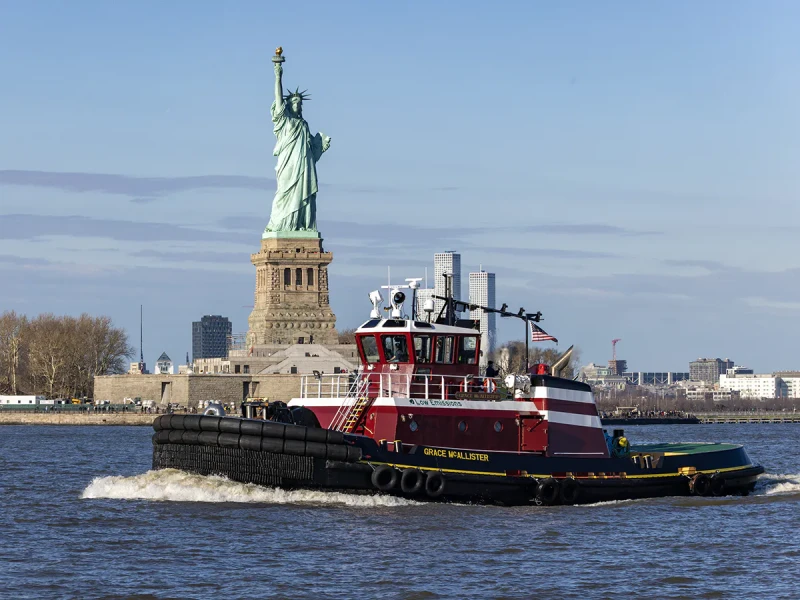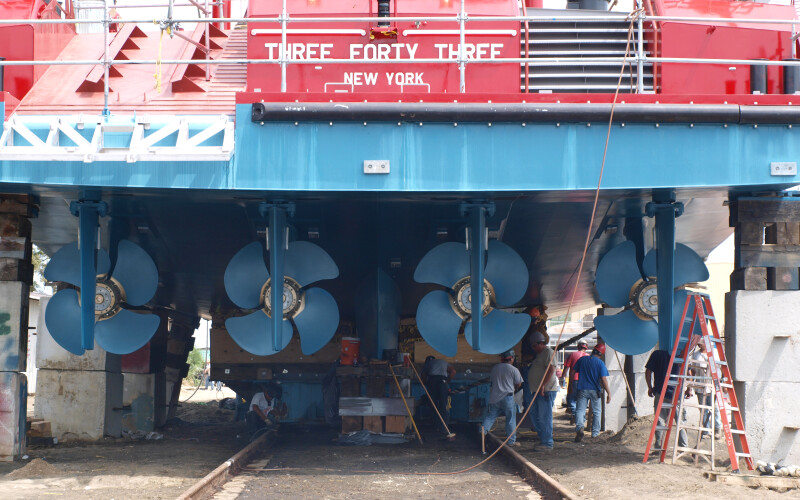According to Merriam Webster, the word propulsion comes from the Latin word propellere, meaning “to push or thrust forward, compel to go forward.” Whatever the workboat, it must be able to thrust forward, be compelled to go forward. Otherwise, the boat is just a large metal object floating in the water.
Luckily for workboat owners, there are many methods of propulsion available — propellers, azimuth thrusters, Z-drives and L-drives, waterjets, controllable pitch propellers (CPP), tunnel thrusters, outdrive propulsion units — to name a few.
HUNDESTED PROPELLER
Hundested Propeller has operated out of Seattle for over 35 years. A couple of years ago the company went looking for a dealer that could sell its products on the East Coast. That’s how AB-Marine in Providence, R.I., got involved.
“Hundested is one of the first to pioneer the controllable pitch propeller technology,” said Brendon Prior, one of AB-Marine’s founders. “They were looking for someone to handle their equipment on the East Coast. That’s us.”
Prior said a CPP has blades that can be rotated around its long axis to change the blade pitch.
With its pitch varied to absorb the maximum engine power, the CPP is efficient for the full range of rotational speeds (RPM), operational conditions (load), and vessel speed. The result is reduced fuel consumption, reduced emissions, and less noise.
Commercial vessels need more power when they are fully loaded than when they’re empty. By adjusting the propeller to the optimal pitch, the engine can operate at maximum power without overloading the system. At lower than maximum vessel speed, fuel consumption can be considerably reduced, and cruising range extended by lowering the engine RPM while increasing the propeller pitch to maintain the required vessel speed.
When maneuvering a vessel with CP propellers, the engines will be on a fixed RPM. Only the pitch is changed, providing instant acceleration, quicker speed from a standstill, and more effective deceleration, making stopping quicker and safer.
AB-Marine sells controllable pitch (CP) systems for a variety of workboats such as ferries, tugs, coastal towing vessels, fireboats, and small tankers.
“Among the CP systems we’ve installed are on a ferry in Miami, a ferry in Massachusetts, a sludge boat in New York and a fireboat in New York,” said Prior. “The controllable pitch system is like changing gears in a car. The most important points are the controllability, fuel efficiency, and reliability.”
Hundested’s CP gearboxes are designed and produced in house with built-in pitch control for the propeller. The hydraulic system of all CP gearboxes includes a double oil pump. One pump is utilized exclusively for the pitch control and the other is utilized for the clutch, a possible shaft brake, and lubrication.
The gearboxes are manufactured for vessels from 300 hp to 4,500 hp, depending on engine RPM and the reduction ratio. All sizes have ground, case-hardened, helical gear wheels. “A lot of people don’t know about controllable pitch,” said Prior. “People who do have it, love it.”
Depending on what you want to do, you increase or decrease the pitch. Prior said many of the bigger, slower workboats have their CPPs in nozzles.
“With controllable pitch, you can fine tune your maneuverability and usually increase your fuel efficiency by 30 percent, leaving your engine at cruise speed,” he said.
STEERPROP
Late last year, Finland-based Steerprop was chosen to supply advanced ice-class bowthrusters to the Canadian coast guard’s new polar icebreaker.
The ship is being designed and built at Seaspan Shipyards. When completed, the ship will be one of the most powerful icebreakers in the world.
The 492'×92' multimission icebreaker will have a displacement of 27,876 metric tons and accommodate up to 100 people.
With a Polar Class 2 (PC2) rating, the second highest ice class according to the International Association of Classification Societies (IACS), it will be able to operate in more difficult ice conditions (including in multiyear ice) and for longer periods than any other Canadian icebreaker.
“The Arctic conditions require extreme reliability — reliability is always the most important thing. Our R and D has always taken this kind of ultimate dependability to be the foundation of everything we do,” said Steerprop’s Juho Rekola, director, sales and project management. “The propulsion system must be able to perform, day in and day out.”
Steerprop will equip the polar icebreaker with two arctic tunnel thrusters specially designed to meet the most demanding ice conditions, even without the protection of tunnel grids. This will be Steerprop’s first delivery of this type of ice-strengthened tunnel thruster. The delivery package also includes a bridge control system and an offline oil filtering system.
Steerprop said it has designed an optimal solution for the scope and operational profile of the icebreaker based on the company’s decades-long experience of delivering ice-classed solutions, and “fit for purpose” resolve.
In addition to optimizing operational performance, the fully integrated propulsion solution will be designed to increase reliability and safety, while reducing lifecycle costs and keeping maintenance requirements at a minimum.
ZF MARINE
ZF Marine announced in November the launch of the latest product in its azimuth thruster (AT) series, the ZF AT 90.
The new, well-mounted, Z-drive thruster is compatible with a wide range of commercial vessels, supporting max power of 1,978 kW/2,651 hp, increasing the power and thrust capabilities of its AT series.
Fully customizable to nearly any hull shape or vessel profile, the ZF AT 90 is designed to be one of the most flexible products on the market. It also supports auto-trolling. In combination with ZF’s ThrusterCommand, the system is designed to ensure precise and efficient propulsion control, ZF said.
The ZF AT 90 can be used as part of a hybrid or fully electric system, requiring reduced engine power during vessel operation, full electric sailing, dynamic positioning, and slow cruising while in electric mode, and more, ZF said.
“Whether a client is operating vessels in the inland waterways or has tugboats, ferries or any number of specialty vessels, such as dredgers, the ZF AT 90 offers significant advantages,” said ZF’s product manager, Walter Fienco.

SCHOTTEL
In January, Washburn & Doughty, East Boothbay, Maine, delivered the 93'×38' tug Grace McAllister to New York-based McAllister Towing.
Main propulsion comes from two Caterpillar 3516E Tier 4 engines delivering a total of 6,770 hp to twin Schottel SRP 490 Z-drive units, giving the tug a bollard pull of 85 metric tons.
Schottel’s RudderPropeller (SRP) is a 360° steerable Z-drive designed to combine maximum maneuverability and bollard pull with course stability during free sailing, always providing powerful thrust in the chosen direction, according to Schottel.
The company said it has installed more than 15,000 SRP systems in low- to medium-speed vessels.
The main distinguishing feature of the SRP is its combination of propulsion unit and azimuth steering, making a rudder superfluous and converting engine power into maximum thrust.




